by Elatia Harris
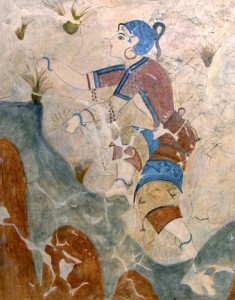
The Saffron Gatherer — one of many girls climbing hills to gather saffron, in Xeste 3, ca. 1750 B.C.E., a large public building in Akrotiri, on Thera (or Santorini). Restoration by painter Thomas Baker.
Part One in a series of articles on aspects of saffron. Photos under the title and below, of wall paintings from the excavated areas of Thera (also called Santorini), are taken from a magnificent site that has expired off the Internet, www.therafoundation.org.
How Far Back Does Saffron Use Go?

50,000 years ago in Western Asia, wild-gathered saffron was rubbed onto sacred stones on hilltop shrines. The sun picked them out, and they shone. Millennia later, saffron gave color, radiant in torchlight, to cave paintings in Iraq. Only relatively recently has the saffron crocus been cultivated, the spice valued as a flavoring for food. Before that, it was a ritual substance, a powerful medicine to relieve melancholy and other ills, and a dye for the clothing of high-born women. The association of saffron with female sexuality is long and intimate, referenced in the Song of Songs, in Homer and in Ovid.
The First Pictorial Record of Saffron and Saffron Culture
Where did the wild saffron crocus first appear? There are competing theories, but it’s down to Central Asia and Greece. Where was it first cultivated? In Greece. Saffron is the dark red thread linking many ancient peoples, and the first pictorial record of it was made in the Cyclades, on the island of Thera – more usually called Santorini – in the Late Bronze Age.
Until 1967, when the excavations of Prof. Spyridon Marinatos began bringing it to light, the clock had been stopped on the settlement of Akrotiri, on the Aegean island of Thera, for about 3,600 years. Volcanic ash from the Thera Eruption, the largest geological event of ancient times, had both destroyed and preserved the town, setting it apart from history for a very long time.

A riverscape, from Akroitiri on the Island of Thera — 1800-1700 BCE
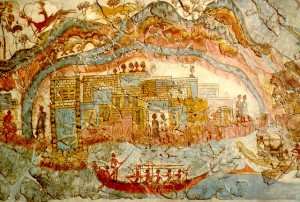
A townscape on the harbor, Akrotiri. 1800-1700 BCE
In the centuries leading up to the eruption, dated around 1650 BCE, Thera was a dolphin-girt paradise, the southernmost island in the Cycladic arc, 70 miles north of Crete. Though Cycladic culture is not quite Minoan, material culture on Thera was rich in Minoan influence, and, through trade, in the influence of Dynastic Egypt. When the language of the Minoans, the tormenting Linear A, is at last understood, more will be revealed. For now, research must be conducted without history’s most ardent kiss — language that we can read.

A German map of the Cyclades and Crete, with Thera (here called Santorini) dead center. Wikimedia Commons
Thanks to the same geothermal activity that would one day disastrously increase, hot water ran in pipes through the multi-storied houses of Akrotiri, Thera’s big town. Ventilation was understood, with light wells sunk in blocks of dwellings. Then as now in the Mediterranean, staples were stored in gigantic ceramic jars – olive oil, grain, dried figs. There was intricate and characteristic jewelry and there was perfume — of coriander, almonds, bergamot and pine. Weaving was so fine that garments could be woven sheer and then embroidered. In the harbor, resinated linen covered the hulls of ships long enough for 30 oarsmen. There were blue-toned vervet monkeys from Egypt, tall stone vases for lilies, and sufficient paint for many radiantly colored and figured walls — had there not been paint, we would know very little of the rest.
And there was saffron. The wild-growing crocus species that produces saffron, C. cartwrightianus, has for purposes of cultivation mostly given over to a selection, C. sativus. Numerous crocus species, some with deep mythological associations, bloom in the late winter, the spring and the fall. C. cartwrightianus and C. sativus, with their petals of violet-blue, bloom in the late fall, a time of tremendous fecundity in both plant and animal life in the Mediterranean. It takes about 70,000 deep orange-red stigma to make a pound of dried saffron.
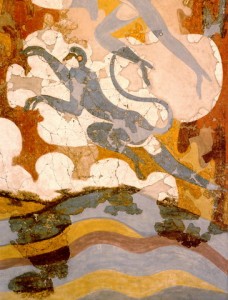

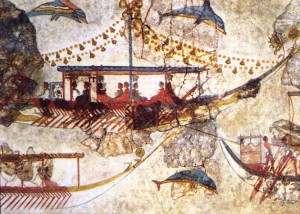
In the building known as Xeste 3, larger and more decorated than any yet excavated at Akrotiri, a two-storied chamber of frescoes – true frescoes, painted on wet plaster for a time-defying bond – depicts women and girls gathering saffron crocus blooms, bringing them in baskets to a saffron-cushioned goddess seated on a three-tiered platform. It is by far the most splendid and evocative cycle of paintings from the ancient world to be discovered in our time, and a match for almost any painting from pre-classical antiquity. Xeste 3 was probably a public building – on an ashlar wall there is an altar surmounted by a painted pair of horns tipped and dripping in red and, below, a lustral basin, both too large for domestic use.
If public or semi-public rituals were performed here, then to what end? And in whose propitiation? And how was saffron involved? The cycle of frescoes in Xeste 3 poses many questions, and answers not a few of them most provocatively.
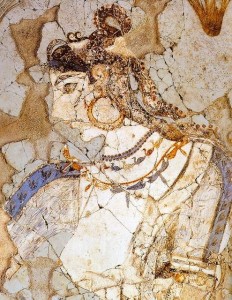
The Goddess on the Saffron Cushion… To be continued.
_______________________________________
SOURCES CONSULTED in the WRITING of THIS ARTICLE
Books
The White Goddess, by Robert Graves
The Masks of God, Vol. 3: Occidental Mythology, by Joseph Campbell
Creation of the Sacred: Tracks of Biology in Early Religion, by Walter Burkert
Art and Religion in Thera: Reconstructing a Bronze Age Society, by Nanno Marinatos
Thera: Pompeii of the Ancient Aegean, by Christos G. Doumas
Web Resources
Botanical Saffron
Excellent articles for determining this aspect of saffron — never make a botany-based mistake about saffron again!
http://gernot-katzers-spice-pages.com/engl/Croc_sat.html
http://en.wikipedia.org/wiki/Crocus_cartwrightianus
http://en.wikipedia.org/wiki/Crocus_sativus
http://www.botanicalgarden.ubc.ca/potd/2005/07/crocus_sativus.php
http://www.thealpinehouse.fsnet.co.uk/crocus%20pages/Crocus%204.htm
http://www.le.ac.uk/ebulletin-archive/ebulletin/news/press-releases/2010-2019/2010/03/nparticle.2010-03-04.html?searchterm=crocus
Wall Paintings of Thera
The best and most complete site left on the Internet — unfortunately the photos are tiny.
http://www.idryma-theras.org.gr/wall_paintings_exhibition.htm
Elatia Harris is a writer and consulting editor in Cambridge, Mass. She is most often at work on books and articles about food, wine and travel. Contact her at elatiaharrisATgmailDOTcom or via text at 617-599-7159.

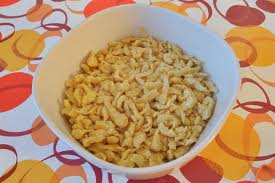





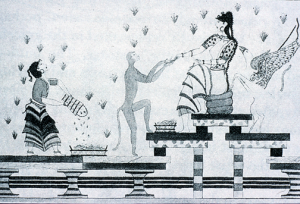
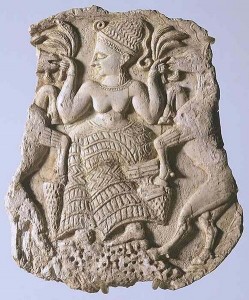

















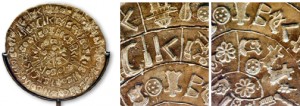




 Thinking and speaking and eating on Santorini
Thinking and speaking and eating on Santorini

























